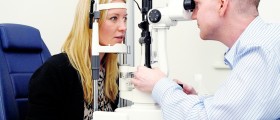
Glaucoma is the disease that affects the eyes, damaging the optic nerve. This disease leads to progressive and irreversible loss of vision. Untreated glaucoma causes permanent injure of the optic nerve and results in the loss of visual field, which can progress to blindness. Glaucoma is the leading cause of blindness in the United States.
It is estimated that somewhere around 2 million Americans suffer from this disease. Certain racial and age groups are at the highest risk, for example: African Americans over the age of 40, or people over age 60, especially Mexican Americans. People with family history of glaucoma are also more prone to develop the disease.
Symptoms and types of glaucoma
For the most of glaucoma cases, there are no obvious symptoms of the disease, until the point where the optic nerve is damaged and peripheral vision is lost.
There are two main types of glaucoma, so called "open angle" and "closed angle" glaucoma. These typical types of glaucoma are characterized by increased intraocular pressure, or pressure inside the eye. Open angle, chronic glaucoma is "the silent thief of sight" as it develops at a slow rate and the patient may not notice that they have lost vision until the disease has progressed significantly.
Closed angle glaucoma usually develops as an effect of another disease that contributes to increased eye pressure. Closed angle glaucoma usually appears suddenly and is often painful. Patients with this type of glaucoma usually seek the medical attention because of the strong pain. Otherwise, visual loss can progress rapidly.
Causes of glaucoma
The main cause of glaucoma is increased pressure within the eye, usually associated with the optic nerve damage. Why is this so, scientists are not completely sure.
The pressure in the eye is caused by a buildup of aqueous humor, a fluid naturally and permanently produced in the front of your eye. Aqueous humor is leaving the eye through a drainage system in the eye. When the drainage system is blocked, aqueous humor can't exit the eye, and the pressure in the eye starts to rise.
Diagnosing glaucoma
Regular eye exams are critical to detection and treatment of the disease. Early detection can protect the eyes from damage and preserve the vision. Regular eye examinations should be conducted frequently, depending on the patient’s age:before age 40, every two to four yearsfrom age 40 to age 54, every one to three yearsfrom age 55 to 64, every one to two yearsafter age 65, every six to 12 monthsTests usually include a visual activity test, a pachymetry test, an optic nerve checkup and an eye pressure check, also known as tonometry.
Treatment
Glaucoma cannot be completely cured, and damage can't be reversed, but treatment and regular checkups can prevent visual loss in people with very early glaucoma. Treatment usually involves the use of eye drops, different oral medications and drugs that protect the optic nerve. For the patients that can’t tolerate medications, doctors may recommend surgery.

















Your thoughts on this
Loading...